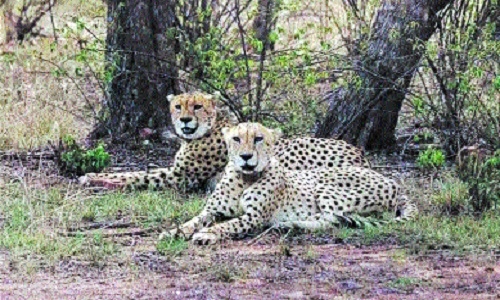Cheetah translocation 2.0 anytime: Official
13 Jun 2024 11:34:03

By Bhavana ‘Aparajita’
Shukla
After green signal from inspection teams of Kenya and South Africa, State is all set ready to launch another edition of cheetah reintroduction project at Gandhi Sagar Wildlife Sanctuary. State Government has completed its preparations to create another home for an ambitious cheetah reintroduction project at Gandhi Sagar Wildlife Sanctuary– the first one is Kuno National Park of Sheopur near the historic town of Gwalior. This Gandhi Sagar sanctuary is set to become the second home for cheetahs in India followed by Kuno National Park, a top forest official told ‘The Hitavada’. Earlier, officials from Kenya and South Africa previously visited Gandhi Sagar to assess the conditions. Chief Minister Mohan Yadav chaired a wildlife board meeting where it was confirmed prey animals have been relocated from Kanha, Satpura, and Sanjay tiger reserves. It was also informed that 50 gaurs (Indian bisons) have also been successfully reintroduced from Kanha and Satpura Tiger Reserve to the Sanjay Tiger Reserve (in Sidhi district).”
Specifically, cheetals (spotted deer) have been reintroduced from Kanha and other areas to boost their population in the region. On September 17, 2022, eight Namibian cheetahs, comprising five females and three males, were released into enclosures at Kuno National Park in Sheopur district. Subsequently, in February 2023, 12 more cheetahs were brought from South Africa. Notably, experts from Kenya and South Africa had earlier visited Gandhi Sagar to assess the conditions and gave a go-ahead. On September 17, 2022, eight Namibian cheetahs, five females and three males were released into enclosures at Kuno National Park in Sheopur district. In February 2023, 12 more cheetahs were brought from South Africa. Kenyan delegation visits MP to review preparations for cheetah reintroduction. Now, only 13 of the 20 adult cheetahs survive. Another 13 cubs born to these cheetahs put the total population of the animals currently in Kuno at 26.
Kenya, SA officials’ go ahead to Gandhi Sagar after assessing conditions
In the worlds’ first intercontinental translocation project of any wild animal, India is going to reintroduce the most elusive of predators; the cheetah to its forests after a wide gap of almost 75 years on 17th of this month. The plan of translocation is more than a decade old. In September 2009, Wildlife Trust of India and Wildlife Institute of India were given a task to see the potential in importing any subspecies of cheetahs to India. Authorities had even picked two parks, Kuno and Nauradehi, among others, for the project as prey base for cheetahs is the densest there in India. But plan comes to a grinding halt when Supreme Court of India stalled the project on the plea of project opponents that a non-native’ species cannot be introduced to the country as the plan for not a “case of intentional movement of a non-native species.”
Later on January 28, 2020, the apex court allowed the translocation of cheetahs from Namibia only on experimental basis in a careful chosen habitat and nurtured and watched to see whether it can adapt to the Indian conditions. In July 2023, it was announced that a batch of eight cheetahs will be introduced to Kuno National park on 15 August when India celebrates its Independence Day but it was postponed again. Later, Prime Minister Narendra Modi toasted the arrival of cheetahs from Namibia on his birthday which falls on September 17. The Kuno National Park is chosen over other national parks like Ranthambore, Madhav National Park, Nauradehi and Gandhi Sagar because the Kuno National Park area is In the worlds’ first intercontinental translocation project of any wild animal, India is going to reintroduce the most elusive of predators; the cheetah to its forests after a wide gap of almost 75 years on 17th of this month. The plan of translocation is more than a decade old. In September 2009, Wildlife Trust of India and Wildlife Institute of India were given a task to see the potential in importing any subspecies of cheetahs to India. Authorities had even picked two parks, Kuno and Nauradehi, among others, for the project as prey base for cheetahs is the densest there in India. But plan comes to a grinding halt when Supreme Court of India stalled the project on the plea of project opponents that a non-native’ species cannot be introduced to the country as the plan for not a “case of intentional movement of a non-native species.”
Later on January 28, 2020, the apex court allowed the translocation of cheetahs from Namibia only on experimental basis in a careful chosen habitat and nurtured and watched to see whether it can adapt to the Indian conditions. In July 2023, it was announced that a batch of eight cheetahs will be introduced to Kuno National park on 15 August when India celebrates its Independence Day but it was postponed again. Later, Prime Minister Narendra Modi toasted the arrival of cheetahs from Namibia on his birthday which falls on September 17. The Kuno National Park is chosen over other national parks like Ranthambore, Madhav National Park, Nauradehi and Gandhi Sagar because the Kuno National Park area is huge- 1235 sq km and the south-eastern portion of this area is patchy connected to Panna- Tiger Reserve through Madhav National Park- Shivpuri Forest Division. Ranthambhore Tiger Reserve in Rajasthan State across the Chambal river is also connected on the north-western side. Thus the forest landscape availability is about 6,800 square kilometre. Expert, wildlife activists and even forest officials have yet not reached on a consensus when did the last cheetah died (or killed) in India. Some say Maharaja Ramanuj Pratap Singh of Sarguja killed the last three cheetahs in 1947.